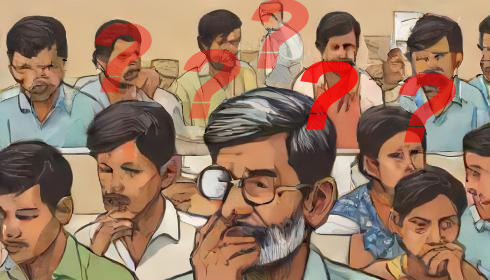
Mental Health Disparities in Los Angeles County Worsened During COVID-19 Pandemic: Surveys
A recent study published in the journal PLOS ONE shed light on the long-term effects of the COVID-19 outbreak in Los Angeles County. Scientists at USC and the Los Angeles County Department of Public Health (DPH) discovered that existing mental health gaps between white and non-white residents widened.
The study used two surveys, one in 2018 and the other in spring 2021, to assess the likelihood of major depression in people, as well as mortality rate data. Researchers examined monthly averages from March 2020, the onset of the first shelter-in-place orders, to mid-April 2021, following the peak of the epidemic. Based on this information, Los Angeles County was divided into three zones: a high COVID-19 mortality area that included metropolitan L.A. and South L.A. County, and East L.A. County; a low COVID-19 mortality area that included West L.A. County and the South Bay; and a middle COVID-19 mortality area that included the San Gabriel, San Fernando, and Antelope Valleys.
Residents in areas with high COVID-19 mortality were more likely to experience depression than those in areas with intermediate and low COVID-19 mortality. When the researchers categorized survey respondents by race, they discovered a clear divide. They discovered an overall tendency for increased depression risk in harder-hit areas among non-white Los Angeles County residents, including Asian, Black, Hispanic, and Indigenous racial and ethnic groupings, but not among white inhabitants.
In 2021, non-white respondents in the area most affected by COVID-19 deaths were more likely to feel depressed than those in the low COVID-19 mortality zone. Even in 2018, non-white residents of metro L.A., South L.A., and East L.A. had a higher risk of depression than non-white residents of West L.A. and the South Bay. By 2021, the gap had grown. Even after controlling for other variables, the researchers' findings remained consistent.
According to the corresponding author, Jonathan Lam, PhD, MPH, assistant professor of research emergency medicine at USC's Keck School of Medicine, the pandemic affected non-whites more severely than whites, and we hypothesized that living conditions had a significant impact on mental health. "You may see people in multigenerational families, which means that when COVID-19 strikes, they will not have enough space to quarantine family members. They might have worked in industries that offered minimal protection and necessitated minimal time off for evaluation. This might significantly increase their stress and undermine their ability to cope with the pandemic."
The study depicts a disparity in the effects of COVID-19 on areas in Los Angeles. Angeles County. In each of the three zones, the death rate from coronavirus was more than twice as high among non-white inhabitants as among white residents. Other figures indicated a significant reversal. In 2018, white L.A. County inhabitants in all three zones had a higher death rate than non-white residents.
The study adds to the growing evidence that the coronavirus has, at least temporarily eliminated the Latino dilemma. "Post-COVID, non-whites have higher mortality," said senior author Neeraj Sood, PhD, a professor at the USC Price School of Public Policy and head of the COVID Initiative at the USC Schaeffer Center for Health Policy and Economics. "There is a significant split in terms of COVID's impact. Depending on who you are and where you reside, your experience during the pandemic could be significantly worse."
The 2021 survey was part of the Los Angeles Pandemic Surveillance Cohort Initiative, which included the USC Schaeffer Center, the Keck School of Medicine's Department of Population and Public Health Sciences, and the Los Angeles County Department of Public Health. The researchers polled 1,222 people from all over the country on how frequently they had experienced a sad mood and a lack of enjoyment from everyday activities in the previous two weeks. The existing 2018 survey included the same measures.
The mental health issues noticed in Los Angeles are part of a larger global phenomenon. According to a 2020 study report, the COVID-19 pandemic has caused serious mental health concerns such as stress, worry, depressive symptoms, insomnia, denial, wrath, and terror. Global studies have revealed a rising frequency of mental health issues among diverse population groupings. Serious psychological repercussions have always been associated with disease pandemics. A recent article in JAMA Psychiatry suggested that COVID-19 could enhance the risk of suicide.
COVID-19 has had a similar impact on mental health in Japan, Singapore, and Iran (Rajkumar, 2020). COVID-19-linked suicides have increased in India. In 2020, an Indian newspaper story reported that the statewide lockdown's grief led to over 300 'non-coronavirus deaths' in India, with suicide being the primary cause.
The Los Angeles study's findings contributed to a better understanding of the pandemic's long-term consequences for mental health in the county. What they discovered may aid attempts to alleviate these difficulties through programs such as the Los Angeles County DPH's Wellness Centers and Community Public Health Teams projects.
"These results raise awareness about the significant impact of living and working conditions on emotional well-being, particularly in lower-income, black, and Latino communities," said co-author William Nicholas, PhD, MPH, director of the Center for Health Impact Evaluation at the Los Angeles County Department of Public Health. "It's vital for us to recognize that improving mental health requires investment in efforts that address the social and economic conditions that influence all health outcomes."
The findings may also help target aid in the event of future virus outbreaks. Lam stated, "A similar epidemic could occur in the future. Our findings present an intriguing test case for how we adapt. When deciding how to deploy mental health resources, we should prioritize the populations with the greatest need."